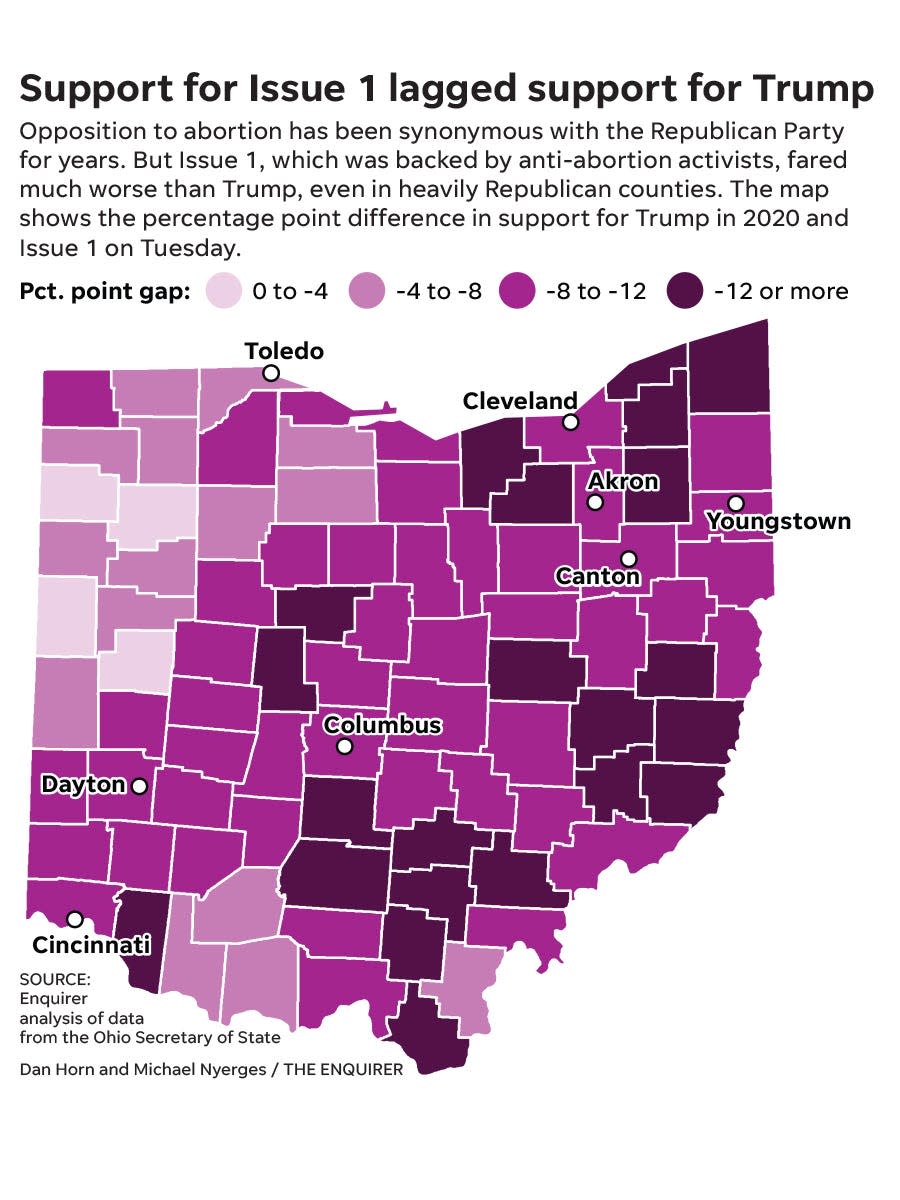Ohio Issue 1 underperformed in GOP counties compared to 2020, 2022 elections

- Oops!Something went wrong.Please try again later.
Throughout the summer, opponents of Issue 1 insisted that Ohioans of all stripes wouldn't buy what supporters were selling.
It turns out they were right.
While Democrats largely drove Issue 1's defeat on Tuesday, Republican strongholds across the state failed to garner enough enthusiasm for the "yes" side. A USA TODAY Network Ohio analysis of unofficial results found support for Issue 1 in all but one county in the state lagged behind support for former President Donald Trump in 2020 and U.S. Sen. J.D. Vance in 2022.
In some cases, Republican-leaning counties flipped entirely.
Ohio Issue 1: What results mean for the Ohio abortion amendment in November
Take Delaware County, a suburban Columbus county that votes loyally − but sometimes narrowly − for Republicans. Vance won the county with 53% of the vote when he ran against former U.S. Rep. Tim Ryan in 2022, and Trump got 52% in 2020. On Tuesday, Issue 1 failed there with just 42% of voters backing it.
Democrats and abortion rights activists said voters defeated Issue 1 because they recognized it was a thinly veiled, Republican-driven attempt to change the state constitution so it would be more difficult to pass an abortion rights amendment in November. "Ohioans saw Issue 1 for what it was," said Rhiannon Carnes, spokeswoman for Ohioans United for Reproductive Rights.
Republican leaders chalked the results up to confusion. They argued certain GOP voters and independents were wooed by the opposition's message about democracy and the importance of majority rule.
"You cannot underestimate the integrity and the intelligence of the voter," said Shawn Parker, chairman for the Delaware County Republican Party. "When parties do that, parties get beat. American people are smart … and we are change resistant without giving us a clear reason to introduce change."
But some political analysts saw Ohio’s rejection of Issue 1 as part of a broader trend in the nation’s politics: When voters are given a choice that could directly impact abortion rights, they choose to affirm those rights. Issue 1 wasn’t technically a referendum on abortion, but opponents and supporters of abortion access understood the stakes in Tuesday’s election.
If Issue 1 had passed, a proposed constitutional amendment on the ballot in November to guarantee legal access to abortion would have required 60% of the vote to win, instead of the 50% plus one that's been required in Ohio for the past century.

How Republican counties voted on Issue 1
Even in red states like Ohio, where Trump won by 8 percentage points in 2020, abortion rights is an issue that pulls support from independents and even from some Republicans, whose party has traditionally supported abortion bans and restrictions.
Though Issue 1 carried most of the counties Trump won in 2020, the margin of victory was much narrower.
In Cincinnati’s pro-Trump suburbs, for example, support in Butler County fell from 61% for Trump to 50% for Issue 1. In Clermont County, it fell from 67% to 54%. Outside Columbus, support for Issue 1 was 11 points lower in Licking County than it was for Trump in 2020, falling from 63% to 52%. Some of the most dramatic shifts happened in reliably Republican strongholds like Jackson and Belmont counties.
In the Youngstown area, voters also flipped Mahoning County, which is ground zero for populist Republicans who used to side with Democrats. Tex Fischer, vice chairman of the Mahoning County GOP, said their voters weren't as motivated over Issue 1, but he doesn't expect that to be the case with the abortion amendment.
“(Abortion is) just a much easier sell for people," Fischer said. "It doesn’t require any hand-holding or explaining like Issue 1 might have. The average person is not thinking about the mechanics for changing the state constitution every day."

Republicans and opponents of abortion access know they have work to do ahead of November. Voters in deep red states such as Kansas and Kentucky have rejected efforts to restrict abortion rights since the U.S. Supreme Court overturned Roe v. Wade last year. A recent Suffolk University/USA TODAY Network poll found 58% of Ohio voters support the proposed amendment, including one-third of Republicans.
"While Issue 1 isn’t a perfect proxy, I think this would raise something of a red flag for the Republican Party that reproductive rights don’t necessarily map perfectly to partisanship," said Melissa Miller, a political scientist at Bowling Green State University.
Can abortion win elections for Ohio Democrats?
Still, anti-abortion advocates dismissed speculation that Tuesday's election is cause for alarm. And some observers cautioned against reading too much into the results of an unusually timed special election in August.
Opposition to abortion restrictions is unlikely to translate any time soon into statewide victories for Democrats in Ohio, which has moved from a swing state to favorable GOP territory over the past decade, said J. Cherie Strachan, director of the Ray C. Bliss Institute of Applied Politics at the University of Akron. The dynamics of issue campaigns, she said, are often different than those in candidate-driven races.
Just because voters cast ballots against Issue 1, Strachan said, "doesn’t mean in 2024 they’re going to vote for Joe Biden."

But Strachan said the issue could give Democrats an opportunity to win more races than they otherwise would. She said the 2022 midterms revealed that younger voters and suburban women may be motivated by abortion to support more Democratic candidates.
Overall, more Americans today, regardless of party affiliation, say abortion should be legal in all or most cases than they did in 2010, according to the Public Religion Research Institute. Among Democrats, support has grown from 71% to 87%. Among Republicans, it’s up from 35% to 37%.
“Democrats will certainly use it as a wedge issue,” Strachan said. “That will likely take time.”
Haley BeMiller and Dan Horn are reporters for the USA TODAY Network, which serves the Columbus Dispatch, Cincinnati Enquirer, Akron Beacon Journal and 18 other affiliated news organizations across Ohio.
Get more political analysis by listening to the Ohio Politics Explained podcast
This article originally appeared on The Columbus Dispatch: Why Ohio Issue 1 underperformed in Republican counties

